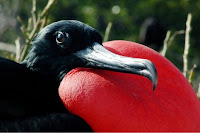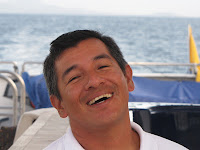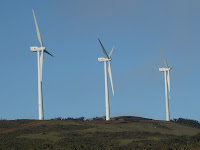 In my blog, I focus on nature in Galapagos - the flora and fauna that define us and make us the most unique ecosystem anywhere in the world. One of the most iconic symbols of conservation in our archipelago is Lonesome George. When he died in September 2012, I wrote a commemorative post, thinking that would be my last about him, But, that's been far from true. I wrote about him again when he was officially designated as a symbol of our cultural heritage. Then, I posted on Facebook about the plan to taxidermy him and about his New York Museum show and ultimate return to Galapagos in 2015. And, I anticipated writing an announcement when he finally returns to Galapagos. But, I never expected to be telling you about what has turned out to be one of his most enduring qualities: George was and remains one stubborn, I mean really stubborn, tortoise.
In my blog, I focus on nature in Galapagos - the flora and fauna that define us and make us the most unique ecosystem anywhere in the world. One of the most iconic symbols of conservation in our archipelago is Lonesome George. When he died in September 2012, I wrote a commemorative post, thinking that would be my last about him, But, that's been far from true. I wrote about him again when he was officially designated as a symbol of our cultural heritage. Then, I posted on Facebook about the plan to taxidermy him and about his New York Museum show and ultimate return to Galapagos in 2015. And, I anticipated writing an announcement when he finally returns to Galapagos. But, I never expected to be telling you about what has turned out to be one of his most enduring qualities: George was and remains one stubborn, I mean really stubborn, tortoise.Tuesday, 11 November 2014
More on Lonesome George - The Icon of Stubborness
 In my blog, I focus on nature in Galapagos - the flora and fauna that define us and make us the most unique ecosystem anywhere in the world. One of the most iconic symbols of conservation in our archipelago is Lonesome George. When he died in September 2012, I wrote a commemorative post, thinking that would be my last about him, But, that's been far from true. I wrote about him again when he was officially designated as a symbol of our cultural heritage. Then, I posted on Facebook about the plan to taxidermy him and about his New York Museum show and ultimate return to Galapagos in 2015. And, I anticipated writing an announcement when he finally returns to Galapagos. But, I never expected to be telling you about what has turned out to be one of his most enduring qualities: George was and remains one stubborn, I mean really stubborn, tortoise.
In my blog, I focus on nature in Galapagos - the flora and fauna that define us and make us the most unique ecosystem anywhere in the world. One of the most iconic symbols of conservation in our archipelago is Lonesome George. When he died in September 2012, I wrote a commemorative post, thinking that would be my last about him, But, that's been far from true. I wrote about him again when he was officially designated as a symbol of our cultural heritage. Then, I posted on Facebook about the plan to taxidermy him and about his New York Museum show and ultimate return to Galapagos in 2015. And, I anticipated writing an announcement when he finally returns to Galapagos. But, I never expected to be telling you about what has turned out to be one of his most enduring qualities: George was and remains one stubborn, I mean really stubborn, tortoise.Wednesday, 5 November 2014
When to Visit Galapagos - Part One
Welcome to Galapagos!
Sea Lions Welcome You at Puerta Villamil, Isabela Island, Galapagos
There's never a bad time to visit Galapagos and October and November are no exception. Though it's considered to be low season here, I think it's a marvelous time for a visit. The weather is great. The sights are as beautiful as at any other time of year. The animals come out to play. The flora has many brilliant colors that you don't see at other times of the year. And, the sky and water are glorious shades of blue. Not only that, it's been my experience that there may be fewer passengers on the ships and visitors at the hotels, so you could get a great rate - to say nothing of extra one-on-one attention. It seems like a great time to schedule your trip.
Sea Lions Welcome You at Puerta Villamil, Isabela Island, Galapagos
There's never a bad time to visit Galapagos and October and November are no exception. Though it's considered to be low season here, I think it's a marvelous time for a visit. The weather is great. The sights are as beautiful as at any other time of year. The animals come out to play. The flora has many brilliant colors that you don't see at other times of the year. And, the sky and water are glorious shades of blue. Not only that, it's been my experience that there may be fewer passengers on the ships and visitors at the hotels, so you could get a great rate - to say nothing of extra one-on-one attention. It seems like a great time to schedule your trip.
Labels:
Galapagos,
Galapagos weather,
Tourist Sites,
Travel,
trip planning
Tuesday, 21 October 2014
Penguin Update
 |
| Galapagos Penguin photo by Joseph Tepper for the Audobon Society |
Tuesday, 14 October 2014
El Niño in 2014? Probably Not.
 |
| Iguanas with Babies Basking in the Sun |
Labels:
El Nino,
Galapagos,
Humboldt Currrent,
ocean currents
Tuesday, 16 September 2014
Isolated Galapagos Connected Through Underwater Super Highways
 |
| Sanjay the Green Sea Turtle |
Tuesday, 2 September 2014
Boobie Population Decline
Everyone knows that one of the reasons for a trip to Galapagos is to get
up close and personal with the Blue Footed Boobie. This iconic representation
of Galapagos is beautiful, fascinating, fun and unique. Watching a boobie
mating dance is sheer delight and seeing the new born fluff-ball chicks is heartwarming.
Tuesday, 26 August 2014
Where the Past Meets the Future - Robots in Galapagos
Tuesday, 19 August 2014
High Tech Galapagos - Not an Oxymoron
 |
| Galapagos UAV |
What we can rely on is our unique endemic animal, bird and marine life that has been around forever. You come here to see preservation, not modernity.
Tuesday, 5 August 2014
In Galapagos We Preserve and We Evolve
Galapagos is THE PLACE for preservation of the species. Nowhere else in the world is so dedicated to maintaining a pristine environment, observing the rules of nature, limiting interference from any non-endemic and indigenous species and not only preserving, but also regenerating, the plant, animal, bird and marine life that makes our unique ecosystem.
Tuesday, 29 July 2014
Fernandina's Fish-Eating Snakes - Adaptation of the Species in Action!
.jpg) |
| Cape Douglas |
Labels:
About the Galapagos Islands,
Fernandina,
scuba diving,
snakes
Tuesday, 1 July 2014
China Hat (Sombrero Chino)
A stand-alone visitor destination in Galapagos, a small islet near Santiago Island, China Hat, also known as Sombrero Chino, is another island absolutely filled with things to see. As you can see from this photo, the island gets its name from its shape. In my last post, I told you about the tiny island of South Plaza. This island is equally tiny, less than 1/4 kilometer, but also equally exciting.
Tuesday, 24 June 2014
South Plaza Island - Small and Mighty
 |
| South Plaza Sunrise Seen from the Panga |
South Plaza is visited by many travelers who choose a cruise for their vacation to the Galapagos Islands. I've noticed that passengers might question what they can possibly experience here because as the cruise ship approaches South Plaza Island, they are likely to be a little underwhelmed by its size. After all its total area is just .08
square miles and at its highest point just 82 feet above sea level. (That's .13
km in area and 23 meters in altitude.)
But, I assure them that they will most certainly not be disappointed. South Plaza is
beautiful and intriguing in every season. And it is teeming with colors, marine
birds and, not surprisingly, sea lions.
Tuesday, 17 June 2014
Isle Lobos - One of San Cristobal's Most Appealing Attractions
 Every day in Galapagos is an adventure and when you stay on San Cristobal Island, all you have to do is jump on a boat and in minutes you are at some of the best visitor sites in Galapagos. One of my favorites, full of adventure and endemic wild life, is Isle Lobos.
Every day in Galapagos is an adventure and when you stay on San Cristobal Island, all you have to do is jump on a boat and in minutes you are at some of the best visitor sites in Galapagos. One of my favorites, full of adventure and endemic wild life, is Isle Lobos.Tuesday, 10 June 2014
Tortoise World-Wide Celebration
We all love our Galapagos Tortoises. I've already told you a lot about Lonesome George, the most famous tortoise ever, not only in Galapagos, but around the world. And, if you've been following the Galapagos Eco-Lodge blog, you know that in Galapagos preservation of these marvelous and unique reptiles is a huge priority of the Charles Darwin Foundation.
But, it turns out that our Galapagos tortoises are not the only celebrated tortoises - not at all. In fact, May 23, 2014 was actually the 14th celebration of international "World Turtle Day." The day was dedicated to educating people about tortoises, turtles and worldwide conversation and preservation efforts.
The day is sponsored by American Tortoise Rescue, a non-profit organization with the mission to protect all species of tortoise and turtle. ATR has placed about 3000 tortoises in caring homes.
Before sharing some fabulous reptile photos with you, I want to take just a moment to tell you the major distinctions between tortoises and turtles. A tortoise lives on the land, eats bushes, vegetation, grass, and cacti. Their feet have adapted for land mobility; thus they have heavily padded feet, instead of webs. Turtles, in contrast, live most of their life in the water, and have webbed feet for swimming. They stay in the water, like our green sea turtles, except when they come to shore to lay eggs or for a brief bask in the sun.
Before sharing some fabulous reptile photos with you, I want to take just a moment to tell you the major distinctions between tortoises and turtles. A tortoise lives on the land, eats bushes, vegetation, grass, and cacti. Their feet have adapted for land mobility; thus they have heavily padded feet, instead of webs. Turtles, in contrast, live most of their life in the water, and have webbed feet for swimming. They stay in the water, like our green sea turtles, except when they come to shore to lay eggs or for a brief bask in the sun.
Some interesting facts:
Turtles can be tiny like this little Bog Turtle (photo courtesy of U.S Fish and Wildlife Service and popsci.com/article/science/its-world-turtle-day):
Tuesday, 3 June 2014
Let's Save the Endangered Galapagos Mangrove Finch
 |
| Mangrove Finch from Save Our Species |
Now, throughout Galapagos, there are only 15 species remaining, the rest having become extinct.
 |
| Medium Ground Finch, Kookr Flickr Creative Commons |
Tuesday, 20 May 2014
Galapagos Finches - From Darwin to the 21st Century
 Most of us were taught in school that the bedrock of Darwin's book Origin of the Species and his theory of adaptation stemmed from his observation of finches in the Galapagos Islands. While on Galapagos, he collected and categorized finches from every island he visited, mostly as a study of what exists, but not why they exist.
Most of us were taught in school that the bedrock of Darwin's book Origin of the Species and his theory of adaptation stemmed from his observation of finches in the Galapagos Islands. While on Galapagos, he collected and categorized finches from every island he visited, mostly as a study of what exists, but not why they exist. It was only after he returned home to England and began studying his samples that he came to the realization that the birds from each island had developed slightly differently. Specifically, depending upon where they lived and the type of vegetation that was available on their particular island, they had developed unique beak styles that provided the best and most efficient access to their food source.
It was only after he returned home to England and began studying his samples that he came to the realization that the birds from each island had developed slightly differently. Specifically, depending upon where they lived and the type of vegetation that was available on their particular island, they had developed unique beak styles that provided the best and most efficient access to their food source.Tuesday, 13 May 2014
The Mysterious Damsel Fish
If you follow my blog you know how much I love to treat my guests to adventures and give them unique memorable moments to remember. This passion of mine isn't limited to the land. I seek out teaching opportunities under water as well. One interesting member of the marine family we examine when snorkeling is the damselfish.
Take a look at this video from my YouTube Channel: Damselfish Providing Security Against Trespass.
When we come across them on our snorkeling excursions, we put the damselfish's most interesting character trait to the test.
Take a look at this video from my YouTube Channel: Damselfish Providing Security Against Trespass.
When we come across them on our snorkeling excursions, we put the damselfish's most interesting character trait to the test.
Tuesday, 6 May 2014
Galapagos: A Hotbed of Scientific Exploration
 One of the behind the scenes aspects of the Galapagos Islands, one that visitors and even natives rarely get to see, is the in-depth and often pivotal scientific research that happens on every island on an ongoing basis. I've written before about the finch research taking place on Daphne. And, I've also written extensively about work done constantly by the Charles Darwin Foundation, particularly with their tortoise breeding programs. The most famous of all is, of course, the effort made with the iconic Lonesome George.
One of the behind the scenes aspects of the Galapagos Islands, one that visitors and even natives rarely get to see, is the in-depth and often pivotal scientific research that happens on every island on an ongoing basis. I've written before about the finch research taking place on Daphne. And, I've also written extensively about work done constantly by the Charles Darwin Foundation, particularly with their tortoise breeding programs. The most famous of all is, of course, the effort made with the iconic Lonesome George. But those are merely the best known of the projects. Research, study and observation are all critical components of our quest for maintaining the pristine quality and the ecological integrity of the islands. In just the last month, results of two new studies were reported in scientific journals. They provide information critical to our understanding of the Galapagos Islands and, equally important, of how much harder we must continue to work to save and protect the biodiversity and natural order throughout the archipelago.
But those are merely the best known of the projects. Research, study and observation are all critical components of our quest for maintaining the pristine quality and the ecological integrity of the islands. In just the last month, results of two new studies were reported in scientific journals. They provide information critical to our understanding of the Galapagos Islands and, equally important, of how much harder we must continue to work to save and protect the biodiversity and natural order throughout the archipelago.Tuesday, 29 April 2014
Galapagos and 21st Century Technology - Can You Hear Me Now?
.JPG) |
| Old-Time Communication |
For those coming to Galapagos who live in large cities and take their connectivity for granted, a visit to the Galapagos Islands can be eye-opening; somewhat like when Dorothy was in Oz and told, "You aren't in Kansas anymore." Here, you are at the frontier of technology, not the cutting edge.
Labels:
Computer,
Floreana Island,
Galapagos Communication,
Wifi
Tuesday, 22 April 2014
Palo Santo Trees
 |
| Common Palo Santo |
 |
| Palo Santos Line the Lava Fields |
Tuesday, 15 April 2014
Daphne Major and Daphne Minor
 |
| Daphne Major at Sunset |
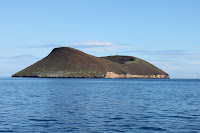 |
| Daphne |
Labels:
Daphne Major,
Daphne Minor,
Galapagos,
Tourist Sites
Tuesday, 8 April 2014
Charles Darwin Research Station - Fifty Years of Conservation
 |
| Charles Darwin Research Foundation |
The scientists and conservationists responsible for founding the CDRS showed tremendous insight and foresight. Long before conservation and sustainability were trendy, the CDRS saw that human intervention was needed to assure survival of the diversity and uniqueness of the Galapagos Islands.
 |
| Tortoise Breeding Project |
Tuesday, 1 April 2014
Galapagos Eco-Lodge Featured in Video Review
The Galapagos Eco-Lodge is so proud to have been featured in a video review that we want to share it with all of our friends and guests.
 To learn more, visit the Galapagos Eco-Lodge website and Facebook pages and see additional reviews in The New York Times and on Trip Advisor.
To learn more, visit the Galapagos Eco-Lodge website and Facebook pages and see additional reviews in The New York Times and on Trip Advisor.Tuesday, 25 March 2014
Luxury Galapagos Style
My friend Ivan and I wrote and perform a song about the Galápagos Islands that is filled with joy and celebrates the natural beauty and magnificent animal and marine life surrounding us. If you listen to the video you'll get the essence of what makes this place we call Paradise so special. I invite you to watch the video and luxuriate in the magnificence we know as the Galápagos Islands.
The Galápagos Islands are unlike anywhere else in the world. That's why this is such a desirable destination. Guests from around the world come here expecting luxurious first class service - and they will get it. There's just one thing: luxury in the Galápagos Islands is unlike what you'll find at the Ritz or Four Seasons or even on Crystal Cruises. Let's call it pampering and opulence "Galapagos style."
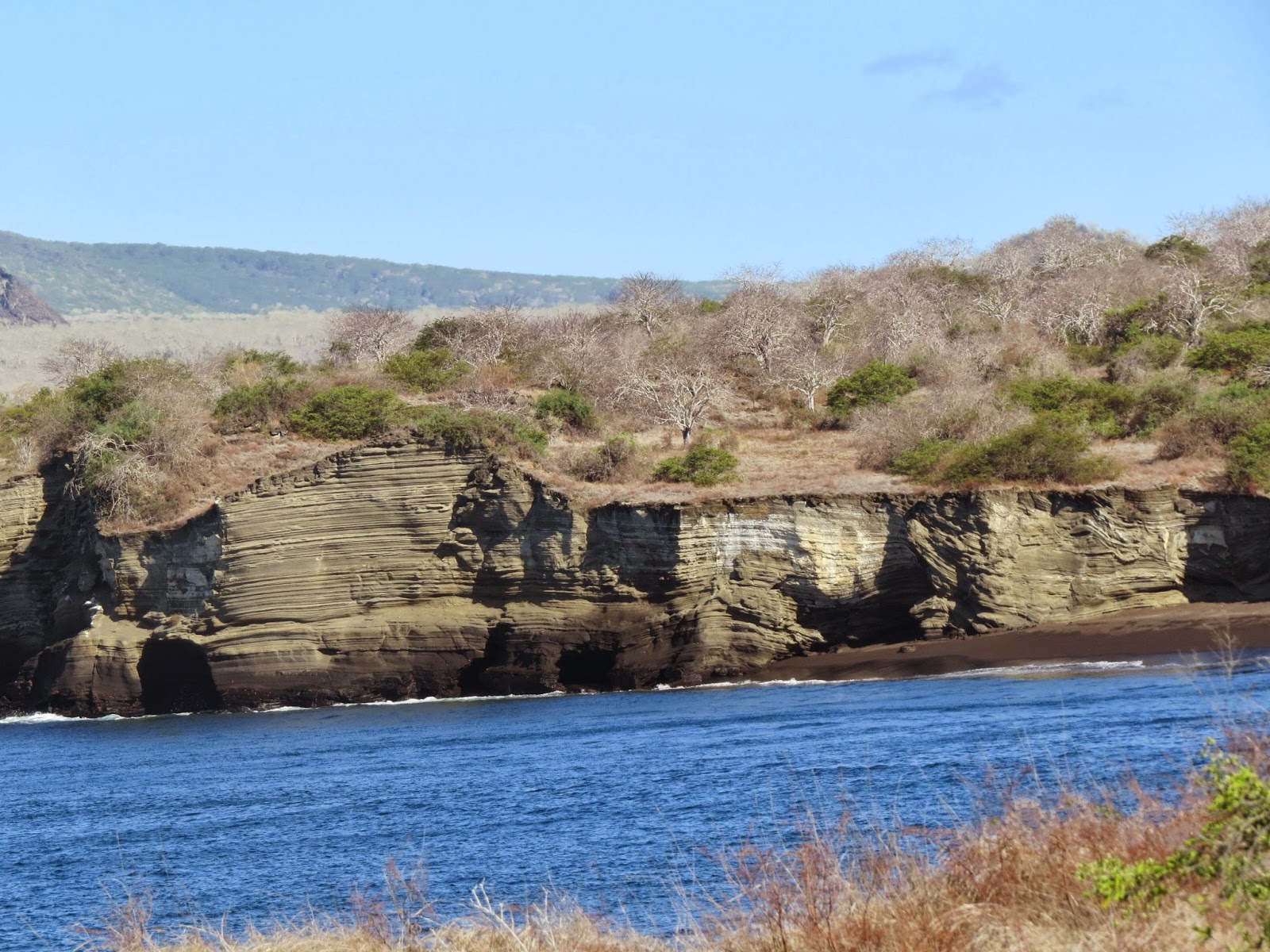 |
| Cliffside Santiago Island Galapagos |
Tuesday, 18 March 2014
Frigate Birds of the Galapagos Islands - The Dating Game
When you go to North Seymour Island in the Galapagos Islands, you will see this ritual repeated over and over again. In their effort to attract a mate, the males perch in the trees in groups, puff up their bright red pouches, extend their considerable wings (with spans of about 6 feet in width) and put on a display for the rather plain (in comparison) females who circle above. The males call out to the girls, sounding either like a drum or a turkey (the sound depends on whether they are Great or Magnificent Frigate Burds) and eventually strike the fancy of one of them.
Tuesday, 11 March 2014
Frigate Birds of the Galapagos Islands - Great and Magnificent
 |
| Frigate Birds off of North Seymour Island |
Tuesday, 4 March 2014
Frigate Birds of the Galapagos Islands - Pirates of the Sea
On every island, around every boat, following diving boobies - it seems that everywhere you look in the Galapagos Islands, you find Frigate Birds.
 You might see them following your cruise ship, or even sitting on the mast.
You might see them following your cruise ship, or even sitting on the mast.
 You might see them following your cruise ship, or even sitting on the mast.
You might see them following your cruise ship, or even sitting on the mast. Tuesday, 25 February 2014
Galapagos Islands - More Than a Bucket List Destination
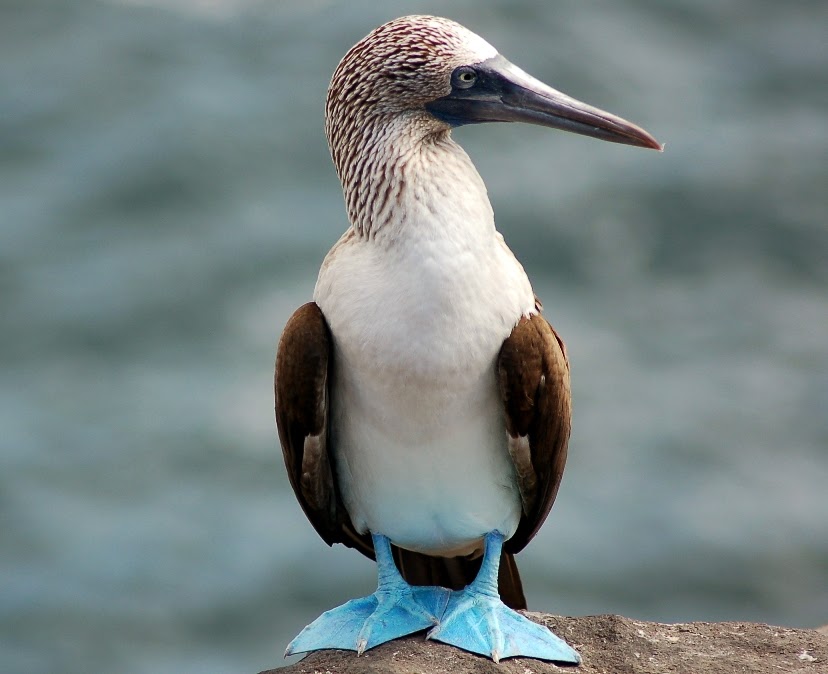 |
| Blue Footed Boobie |
But I admit I have developed a bit of a bias against my home being a destination merely to be checked off a bucket list. It is so much more.
First, consider my perspective. I've lived here all my life. I revel in the beauty, power and uniqueness that surround me. I never tire of this world. Every sea lion is distinctive. Every inch of lava is a work of art. Every day is a chance to learn and expand my appreciation of the planet. So, here's my dilemma: it's been my experience that those who come here just because it's on their bucket list run the risk of overlooking some of the real highlights of their visit. They can be so determined to make it through the list that they fail to immerse themselves in where they are in the moment.
Tuesday, 18 February 2014
What to Expect on Your Trip to the Galapagos Islands
I’ve lived on the Galapagos Islands all of my life and I’ve led nearly 1,000 groups of tourists to places throughout these remarkable islands. It goes without saying that I have learned many things in these years. But, above them all is this: Come to the Galapagos Islands prepared to expect the unexpected! The Islands never cease to amaze me. I always find something new, something inspirational and something I never anticipated.
 |
| Kicker Rock Just an hour's boat ride from the Galapagos Eco-Lodge |
Tuesday, 11 February 2014
Santa Cruz Island - Academy Bay - Clearest Waters in the World
 |
| Puerto Ayora, Academy Bay |
 |
| Crystal Clear Waters of Academy Bay |
Labels:
Academy Bay,
Galapagos,
Galapagos Islands,
Puerto Ayora,
Santa Cruz,
Travel,
Visitor Sites
Tuesday, 4 February 2014
North Seymour Island
 |
| Sunset Over North Seymour Island |
 |
| North Seymour's Rugged Coastline |
Labels:
Blue Footed Boobies,
Galapagos,
North Seymour Island
Tuesday, 28 January 2014
Charles Darwin - the Name and Theory Associated with the Galapagos Islands
 The Galapagos Islands represent natural beauty and stand as the symbol for the origin and evolution of life on Earth. Equally, they represent the Earth’s past and future conservation and preservation efforts. Ecological interaction with the planet is epitomized in the way humans interact with the animals, marine life, birds and even the land itself. This is a most phenomenal archipelago, and Charles Darwin played a major role in making it so.
The Galapagos Islands represent natural beauty and stand as the symbol for the origin and evolution of life on Earth. Equally, they represent the Earth’s past and future conservation and preservation efforts. Ecological interaction with the planet is epitomized in the way humans interact with the animals, marine life, birds and even the land itself. This is a most phenomenal archipelago, and Charles Darwin played a major role in making it so. While Charles Darwin did not discover the Galapagos Islands, he is the name most associated with their history and recognition. For it was Charles Darwin, a young naturalist, who came to the Islands, observed the plant, marine, bird and animal life and designed the intellectual premise known as natural selection or survival of the fittest. His thoughtful interpretation of what he saw and recorded changed human thought and understanding of the world around us forever. He saw continuity and coherency despite the diversity on each island and was able to merge these observations into a cogent scientific process that explains how life on earth evolved.
While Charles Darwin did not discover the Galapagos Islands, he is the name most associated with their history and recognition. For it was Charles Darwin, a young naturalist, who came to the Islands, observed the plant, marine, bird and animal life and designed the intellectual premise known as natural selection or survival of the fittest. His thoughtful interpretation of what he saw and recorded changed human thought and understanding of the world around us forever. He saw continuity and coherency despite the diversity on each island and was able to merge these observations into a cogent scientific process that explains how life on earth evolved.Tuesday, 21 January 2014
The Galapagos Sky
.JPG) Recently, I decided to focus my camera on the sky in the Galapagos Islands. Our sky is a phenomenon unto itself. Together the ocean currents, the volcanic mountains and the wind create constant natural forces that affect and change the sky above us. The mornings may be overcast or sunny. There may be a rainbow or glistening sun over a volcano. As the sun rises in the sky, it may be covered in haze, blazing in a bright blue sky, or filled with puffy white clouds.
Recently, I decided to focus my camera on the sky in the Galapagos Islands. Our sky is a phenomenon unto itself. Together the ocean currents, the volcanic mountains and the wind create constant natural forces that affect and change the sky above us. The mornings may be overcast or sunny. There may be a rainbow or glistening sun over a volcano. As the sun rises in the sky, it may be covered in haze, blazing in a bright blue sky, or filled with puffy white clouds. At sunset, the ball of fire sets in arrays of oranges, yellows and reds, sometimes bathing the surrounding lava in a golden glow. At any time of day, it's filled with marine birds. The sky here is always changing and always beautiful.
At sunset, the ball of fire sets in arrays of oranges, yellows and reds, sometimes bathing the surrounding lava in a golden glow. At any time of day, it's filled with marine birds. The sky here is always changing and always beautiful.Tuesday, 14 January 2014
San Cristobal's Wind Project - The Galapagos Eco-Lodge's Commitment to Fuel Conservation
 The Galapagos Eco-Lodge is committed to the environment and sustainability in more than words. It is not just our personal philosophy, but a pledge that we put into action every single day.
The Galapagos Eco-Lodge is committed to the environment and sustainability in more than words. It is not just our personal philosophy, but a pledge that we put into action every single day.At the heart of this commitment is the elimination of environmental impact from the use of fossil fuels. Already, fully 60% of our power usage is from wind turbines.
San Cristobal Island is my home and the location of the Galapagos Eco-Lodge. It is also the site of one of the most dramatic and important conservation efforts anywhere in the world – the San Cristobal Wind Project. As such, it makes it an ideal spot for the eco-tourist and, indeed, for anyone interested in preservation and conservation of our planet.
Subscribe to:
Posts (Atom)









